SKODA ROOMSTER 2014 1.G Manual Online
Manufacturer: SKODA, Model Year: 2014, Model line: ROOMSTER, Model: SKODA ROOMSTER 2014 1.GPages: 204, PDF Size: 14.15 MB
Page 81 of 204
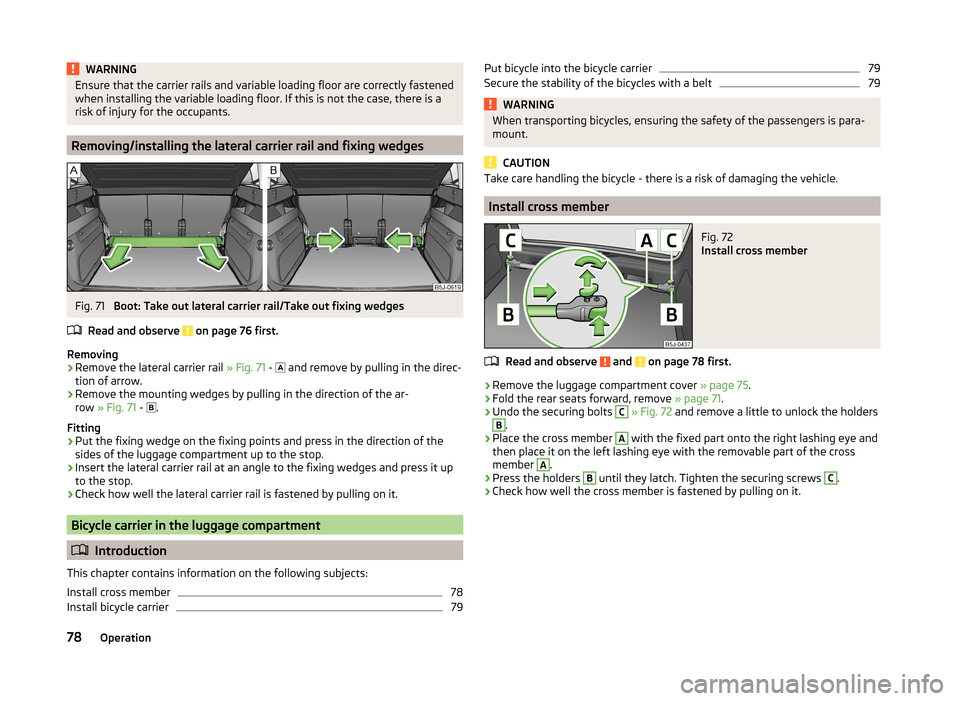
WARNINGEnsure that the carrier rails and variable loading floor are correctly fastened
when installing the variable loading floor. If this is not the case, there is a
risk of injury for the occupants.
Removing/installing the lateral carrier rail and fixing wedges
Fig. 71
Boot: Take out lateral carrier rail/Take out fixing wedges
Read and observe
on page 76 first.
Removing
›
Remove the lateral carrier rail » Fig. 71 -
and remove by pulling in the direc-
tion of arrow.
›
Remove the mounting wedges by pulling in the direction of the ar-
row » Fig. 71 -
.
Fitting
›
Put the fixing wedge on the fixing points and press in the direction of the
sides of the luggage compartment up to the stop.
›
Insert the lateral carrier rail at an angle to the fixing wedges and press it up
to the stop.
›
Check how well the lateral carrier rail is fastened by pulling on it.
Bicycle carrier in the luggage compartment
Introduction
This chapter contains information on the following subjects:
Install cross member
78
Install bicycle carrier
79Put bicycle into the bicycle carrier79Secure the stability of the bicycles with a belt79WARNINGWhen transporting bicycles, ensuring the safety of the passengers is para-
mount.
CAUTION
Take care handling the bicycle - there is a risk of damaging the vehicle.
Install cross member
Fig. 72
Install cross member
Read and observe and on page 78 first.
›
Remove the luggage compartment cover » page 75.
›
Fold the rear seats forward, remove » page 71.
›
Undo the securing bolts
C
» Fig. 72 and remove a little to unlock the holders
B
.
›
Place the cross member
A
with the fixed part onto the right lashing eye and
then place it on the left lashing eye with the removable part of the cross
member
A
.
›
Press the holders
B
until they latch. Tighten the securing screws
C
.
›
Check how well the cross member is fastened by pulling on it.
78Operation
Page 82 of 204
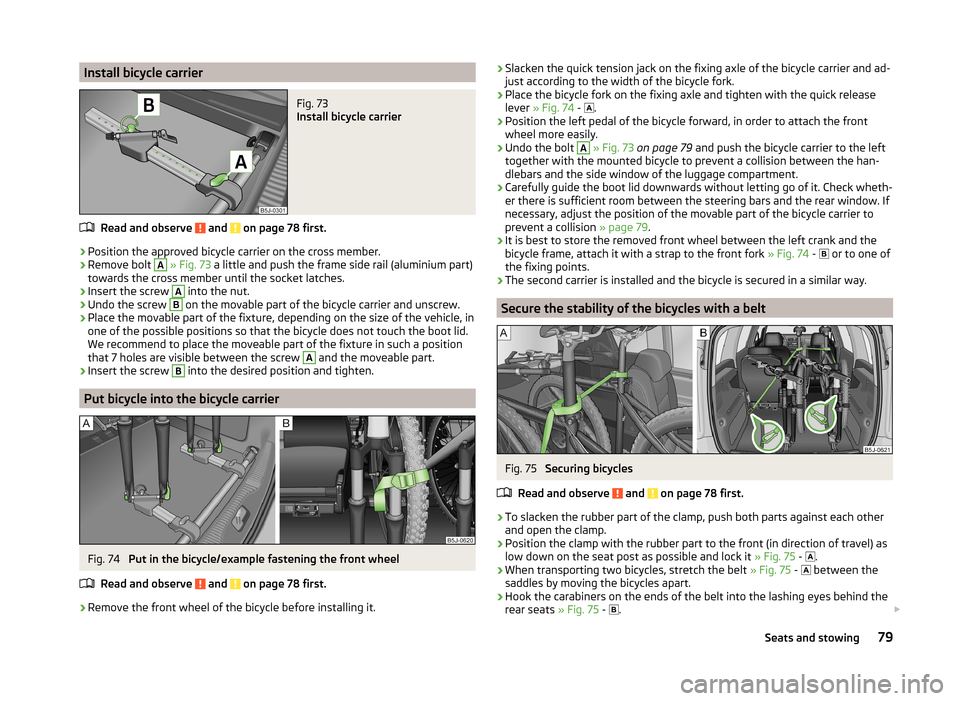
Install bicycle carrierFig. 73
Install bicycle carrier
Read and observe and on page 78 first.
›
Position the approved bicycle carrier on the cross member.
›
Remove bolt
A
» Fig. 73 a little and push the frame side rail (aluminium part)
towards the cross member until the socket latches.
›
Insert the screw
A
into the nut.
›
Undo the screw
B
on the movable part of the bicycle carrier and unscrew.
›
Place the movable part of the fixture, depending on the size of the vehicle, in
one of the possible positions so that the bicycle does not touch the boot lid.
We recommend to place the moveable part of the fixture in such a position
that 7 holes are visible between the screw
A
and the moveable part.
›
Insert the screw
B
into the desired position and tighten.
Put bicycle into the bicycle carrier
Fig. 74
Put in the bicycle/example fastening the front wheel
Read and observe
and on page 78 first.
›
Remove the front wheel of the bicycle before installing it.
› Slacken the quick tension jack on the fixing axle of the bicycle carrier and ad-
just according to the width of the bicycle fork.›
Place the bicycle fork on the fixing axle and tighten with the quick release
lever » Fig. 74 -
.
›
Position the left pedal of the bicycle forward, in order to attach the front
wheel more easily.
›
Undo the bolt
A
» Fig. 73 on page 79 and push the bicycle carrier to the left
together with the mounted bicycle to prevent a collision between the han-
dlebars and the side window of the luggage compartment.
›
Carefully guide the boot lid downwards without letting go of it. Check wheth-
er there is sufficient room between the steering bars and the rear window. If
necessary, adjust the position of the movable part of the bicycle carrier to
prevent a collision » page 79.
›
It is best to store the removed front wheel between the left crank and the
bicycle frame, attach it with a strap to the front fork » Fig. 74 -
or to one of
the fixing points.
›
The second carrier is installed and the bicycle is secured in a similar way.
Secure the stability of the bicycles with a belt
Fig. 75
Securing bicycles
Read and observe
and on page 78 first.
›
To slacken the rubber part of the clamp, push both parts against each other
and open the clamp.
›
Position the clamp with the rubber part to the front (in direction of travel) as
low down on the seat post as possible and lock it » Fig. 75 -
.
›
When transporting two bicycles, stretch the belt
» Fig. 75 -
between the
saddles by moving the bicycles apart.
›
Hook the carabiners on the ends of the belt into the lashing eyes behind the
rear seats » Fig. 75 -
.
79Seats and stowing
Page 83 of 204
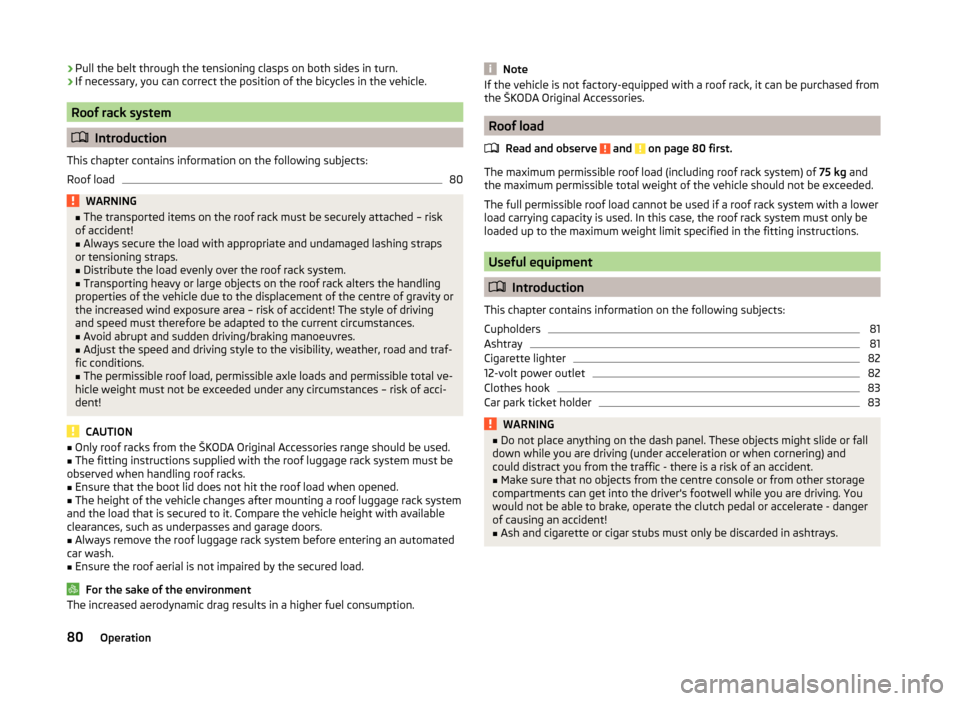
›Pull the belt through the tensioning clasps on both sides in turn.›If necessary, you can correct the position of the bicycles in the vehicle.
Roof rack system
Introduction
This chapter contains information on the following subjects:
Roof load
80WARNING■ The transported items on the roof rack must be securely attached – risk
of accident!■
Always secure the load with appropriate and undamaged lashing straps
or tensioning straps.
■
Distribute the load evenly over the roof rack system.
■
Transporting heavy or large objects on the roof rack alters the handling
properties of the vehicle due to the displacement of the centre of gravity or
the increased wind exposure area – risk of accident! The style of driving
and speed must therefore be adapted to the current circumstances.
■
Avoid abrupt and sudden driving/braking manoeuvres.
■
Adjust the speed and driving style to the visibility, weather, road and traf-
fic conditions.
■
The permissible roof load, permissible axle loads and permissible total ve-
hicle weight must not be exceeded under any circumstances – risk of acci-
dent!
CAUTION
■ Only roof racks from the ŠKODA Original Accessories range should be used.■The fitting instructions supplied with the roof luggage rack system must be
observed when handling roof racks.■
Ensure that the boot lid does not hit the roof load when opened.
■
The height of the vehicle changes after mounting a roof luggage rack system
and the load that is secured to it. Compare the vehicle height with available
clearances, such as underpasses and garage doors.
■
Always remove the roof luggage rack system before entering an automated
car wash.
■
Ensure the roof aerial is not impaired by the secured load.
For the sake of the environment
The increased aerodynamic drag results in a higher fuel consumption.NoteIf the vehicle is not factory-equipped with a roof rack, it can be purchased from
the ŠKODA Original Accessories.
Roof load
Read and observe
and on page 80 first.
The maximum permissible roof load (including roof rack system) of 75 kg and
the maximum permissible total weight of the vehicle should not be exceeded.
The full permissible roof load cannot be used if a roof rack system with a lower
load carrying capacity is used. In this case, the roof rack system must only be
loaded up to the maximum weight limit specified in the fitting instructions.
Useful equipment
Introduction
This chapter contains information on the following subjects:
Cupholders
81
Ashtray
81
Cigarette lighter
82
12-volt power outlet
82
Clothes hook
83
Car park ticket holder
83WARNING■ Do not place anything on the dash panel. These objects might slide or fall
down while you are driving (under acceleration or when cornering) and
could distract you from the traffic - there is a risk of an accident.■
Make sure that no objects from the centre console or from other storage
compartments can get into the driver's footwell while you are driving. You
would not be able to brake, operate the clutch pedal or accelerate - danger
of causing an accident!
■
Ash and cigarette or cigar stubs must only be discarded in ashtrays.
80Operation
Page 84 of 204

CupholdersFig. 76
Cup holder
Read and observe
on page 80 first.
Two beverage containers can be placed in the recesses
A
» Fig. 76 .
One beverage container can be placed into the recess
B
.
WARNING■ Never put hot cups in the cup holder. They may spill if the vehicle moves –
there is a risk of scalding.■
No objects should be placed in the holders that might endanger the vehi-
cle's occupants if the vehicle brakes suddenly or the vehicle is in collision.
■
Do not use any cups or beakers made of fragile material (e.g. glass, porce-
lain). This could lead to injuries in the event of an accident.
CAUTION
Do not leave open beverage containers in the cup holder during the journey.
There is a risk of spilling e.g. when braking which may cause damage to the
electrical components or seat upholstery.AshtrayFig. 77
Centre console: Ashtray at the front/rear
Read and observe
on page 80 first.
The ashtray can be used for discarding ash, cigarettes, cigars and the like » .
Removing
›
Pull out the ashtray » Fig. 77 upwards.
Fitting
›
Insert the ashtray vertically.
WARNINGNever place flammable objects in the ashtray – risk of fire!
CAUTION
When removing, do not hold the ashtray at the cover – risk of breakage.81Seats and stowing
Page 85 of 204
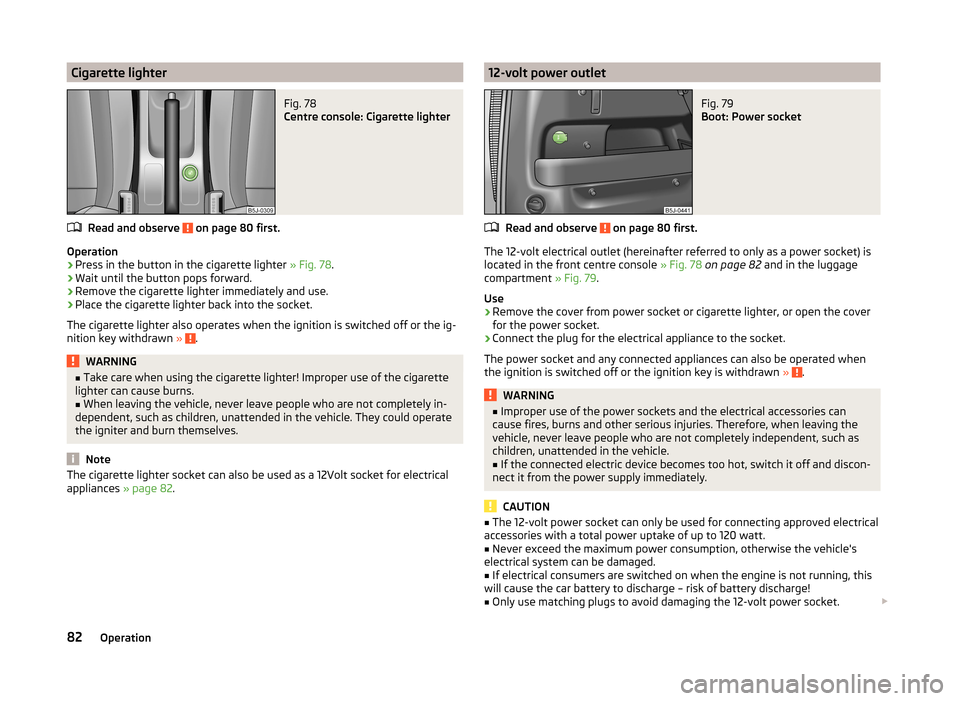
Cigarette lighterFig. 78
Centre console: Cigarette lighter
Read and observe on page 80 first.
Operation
›
Press in the button in the cigarette lighter » Fig. 78.
›
Wait until the button pops forward.
›
Remove the cigarette lighter immediately and use.
›
Place the cigarette lighter back into the socket.
The cigarette lighter also operates when the ignition is switched off or the ig-
nition key withdrawn »
.
WARNING■
Take care when using the cigarette lighter! Improper use of the cigarette
lighter can cause burns.■
When leaving the vehicle, never leave people who are not completely in-
dependent, such as children, unattended in the vehicle. They could operate
the igniter and burn themselves.
Note
The cigarette lighter socket can also be used as a 12Volt socket for electrical
appliances » page 82.12-volt power outletFig. 79
Boot: Power socket
Read and observe on page 80 first.
The 12-volt electrical outlet (hereinafter referred to only as a power socket) is
located in the front centre console » Fig. 78 on page 82 and in the luggage
compartment » Fig. 79.
Use
›
Remove the cover from power socket or cigarette lighter, or open the cover
for the power socket.
›
Connect the plug for the electrical appliance to the socket.
The power socket and any connected appliances can also be operated when
the ignition is switched off or the ignition key is withdrawn »
.
WARNING■
Improper use of the power sockets and the electrical accessories can
cause fires, burns and other serious injuries. Therefore, when leaving the
vehicle, never leave people who are not completely independent, such as
children, unattended in the vehicle.■
If the connected electric device becomes too hot, switch it off and discon-
nect it from the power supply immediately.
CAUTION
■ The 12-volt power socket can only be used for connecting approved electrical
accessories with a total power uptake of up to 120 watt.■
Never exceed the maximum power consumption, otherwise the vehicle's
electrical system can be damaged.
■
If electrical consumers are switched on when the engine is not running, this
will cause the car battery to discharge – risk of battery discharge!
■
Only use matching plugs to avoid damaging the 12-volt power socket.
82Operation
Page 86 of 204
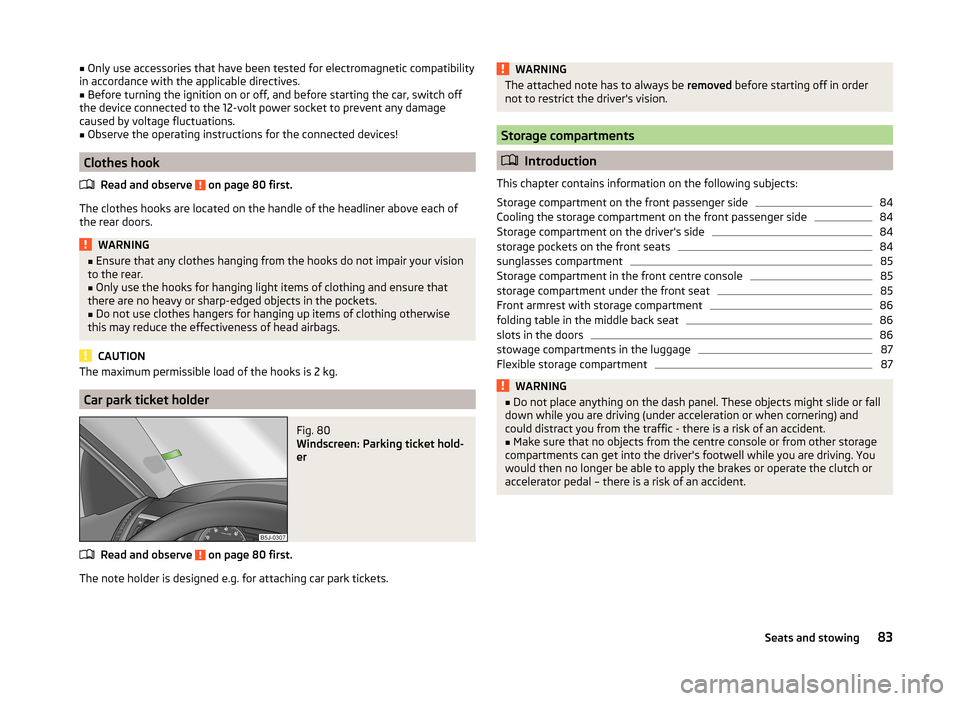
■Only use accessories that have been tested for electromagnetic compatibility
in accordance with the applicable directives.■
Before turning the ignition on or off, and before starting the car, switch off
the device connected to the 12-volt power socket to prevent any damage
caused by voltage fluctuations.
■
Observe the operating instructions for the connected devices!
Clothes hook
Read and observe
on page 80 first.
The clothes hooks are located on the handle of the headliner above each ofthe rear doors.
WARNING■ Ensure that any clothes hanging from the hooks do not impair your vision
to the rear.■
Only use the hooks for hanging light items of clothing and ensure that
there are no heavy or sharp-edged objects in the pockets.
■
Do not use clothes hangers for hanging up items of clothing otherwise
this may reduce the effectiveness of head airbags.
CAUTION
The maximum permissible load of the hooks is 2 kg.
Car park ticket holder
Fig. 80
Windscreen: Parking ticket hold-
er
Read and observe on page 80 first.
The note holder is designed e.g. for attaching car park tickets.
WARNINGThe attached note has to always be removed before starting off in order
not to restrict the driver's vision.
Storage compartments
Introduction
This chapter contains information on the following subjects:
Storage compartment on the front passenger side
84
Cooling the storage compartment on the front passenger side
84
Storage compartment on the driver's side
84
storage pockets on the front seats
84
sunglasses compartment
85
Storage compartment in the front centre console
85
storage compartment under the front seat
85
Front armrest with storage compartment
86
folding table in the middle back seat
86
slots in the doors
86
stowage compartments in the luggage
87
Flexible storage compartment
87WARNING■ Do not place anything on the dash panel. These objects might slide or fall
down while you are driving (under acceleration or when cornering) and
could distract you from the traffic - there is a risk of an accident.■
Make sure that no objects from the centre console or from other storage
compartments can get into the driver's footwell while you are driving. You
would then no longer be able to apply the brakes or operate the clutch or
accelerator pedal – there is a risk of an accident.
83Seats and stowing
Page 87 of 204
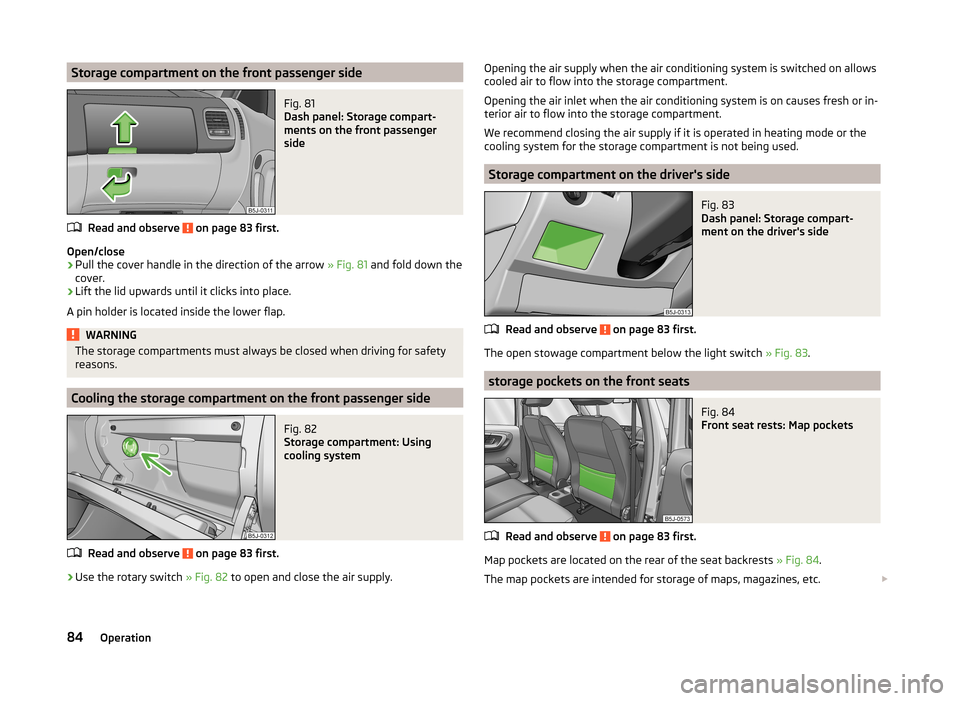
Storage compartment on the front passenger sideFig. 81
Dash panel: Storage compart-
ments on the front passenger
side
Read and observe on page 83 first.
Open/close
›
Pull the cover handle in the direction of the arrow » Fig. 81 and fold down the
cover.
›
Lift the lid upwards until it clicks into place.
A pin holder is located inside the lower flap.
WARNINGThe storage compartments must always be closed when driving for safety
reasons.
Cooling the storage compartment on the front passenger side
Fig. 82
Storage compartment: Using
cooling system
Read and observe on page 83 first.
›
Use the rotary switch » Fig. 82 to open and close the air supply.
Opening the air supply when the air conditioning system is switched on allows
cooled air to flow into the storage compartment.
Opening the air inlet when the air conditioning system is on causes fresh or in-
terior air to flow into the storage compartment.
We recommend closing the air supply if it is operated in heating mode or the
cooling system for the storage compartment is not being used.
Storage compartment on the driver's side
Fig. 83
Dash panel: Storage compart-
ment on the driver's side
Read and observe on page 83 first.
The open stowage compartment below the light switch » Fig. 83.
storage pockets on the front seats
Fig. 84
Front seat rests: Map pockets
Read and observe on page 83 first.
Map pockets are located on the rear of the seat backrests » Fig. 84.
The map pockets are intended for storage of maps, magazines, etc.
84Operation
Page 88 of 204

WARNINGNever put heavy items in the map pockets – risk of injury.
CAUTION
Do not put any large items such as bottles or sharp objects into the map pock-
ets, as the pockets and the seat covers could be damaged.
sunglasses compartment
Fig. 85
Detail of the headliner: Glasses
storage box
Read and observe on page 83 first.
›
Press on the bar in the cover of the glasses storage. The compartment folds
down » Fig. 85 .
WARNINGThe compartment must only be opened when removing or inserting the
spectacles and otherwise must be kept closed.
CAUTION
■ Do not put any heat-sensitive objects in the glasses storage box - they may
be damaged.■
The maximum permissible load of the glasses compartment is 250 g.
Storage compartment in the front centre consoleFig. 86
Centre console: Stowage com-
partment
Read and observe on page 83 first.
The open stowage compartment in the centre console » Fig. 86.
storage compartment under the front seat
Fig. 87
Front seat: Stowage compart-
ment
Read and observe on page 83 first.
›
Pull the handle to open the lid » Fig. 87.
›
When closing the lid, hold the handle until the compartment is closed.
WARNINGThe storage compartment must always be closed when driving for safety
reasons.
CAUTION
The storage compartment is designed for storing small objects of up to 1 kg. in
weight.85Seats and stowing
Page 89 of 204

Front armrest with storage compartmentFig. 88
Armrest: Storage compartment/open storage compartment
Read and observe
on page 83 first.
Fold the armrest forwards
›
Press the lower button on the end of the armrest » Fig. 88 -
.
›
Fold the arm rest forward and release the button again.
Opening the storage compartment
›
Press the upper button and open the cover of the stowage compartment up-
wards » Fig. 88 -
.
Note
The moving space of the arms can be restricted if the armrest is folded for-
wards. In city traffic the armrest should not be folded forwards.
folding table in the middle back seat
Fig. 89
Rear seats: Armrest
Read and observe on page 83 first.
The centre seat back can be used as an armrest forward or table with cup
holders » Fig. 89 by folding it forwards » page 71, Fold downseat backrest and
seat fold down completely .
Two beverage containers can be placed into the recesses.
WARNING■ Never put hot beverage containers in the cup holder. They may spill if the
vehicle moves – there is a risk of scalding.■
Do not use any cups or beakers made of fragile material (e.g. glass, porce-
lain). This could lead to injuries in the event of an accident.
CAUTION
■ Do not leave open beverage containers in the cup holder during the journey.
There is a risk of spilling e.g. when braking which may cause damage to the
electrical components or seat upholstery.■
If the middle rear seat backrest should be folded forward for lengthy periods,
then make sure that the belt locks are not located below it - this can warp the
upholstery or fabric.
slots in the doors
Fig. 90
Storage compartment: in the front door/in the rear door
Read and observe
on page 83 first.
There is a bottle holder at
B
» Fig. 90 of the pocket in the front doors.
86Operation
Page 90 of 204

WARNINGUse the section A » Fig. 90 of the door pocket only for storing objects
which do not project so that the effectiveness of the side airbag is not im-
paired.
stowage compartments in the luggage
Fig. 91
Storage compartments in the
side trim panel
Read and observe on page 83 first.
Storage compartments are located on both sides of the luggage compart-
ment » Fig. 91 .
CAUTION
The storage compartments are designed for storing small objects of up to 1.5
kg. in weight in total.
Flexible storage compartment
Fig. 92
Flexible storage compartment
Read and observe on page 83 first.
The flexible storage compartment » Fig. 92 can be fitted to the right-hand side
of the luggage compartment.
Fitting›Insert both ends of the flexible storage compartment into the openings of
the right side trim panel of the boot and push it downwards until it locks.
Removing›
Grasp the flexible storage compartment on the two upper corners.
›
Press the upper corners inwards and release the storage compartment by
pulling upwards.
›
Remove by pulling towards you.
CAUTION
The storage compartment is designed for storing small objects with a maxi-
mum total weight of 8 kg.
Note
If the variable loading floor » page 76 is installed in the luggage compartment,
no flexible storage compartment can be installed.
Praktik
Introduction
This chapter contains information on the following subjects:
Lashings
88
Adjustable safety partition behind the front seats
88
Attachment of the loading floor
88
Adjustment of the safety partition
88
Emergency release of the loading area door
89
Interior lighting
89WARNINGThe load to be transported must always be secured safely so that it does
not come loose when making an emergency braking or in a vehicle collision
which could cause injuries to occupants.87Seats and stowing